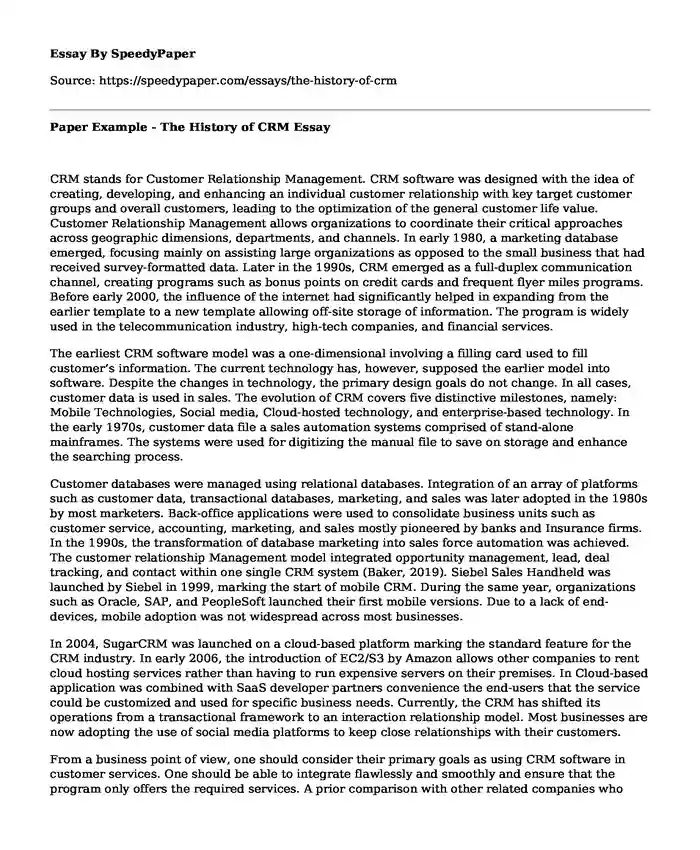
| Type of paper: | Essay |
| Categories: | Management Business Customer service |
| Pages: | 3 |
| Wordcount: | 574 words |
CRM stands for Customer Relationship Management. CRM software was designed with the idea of creating, developing, and enhancing an individual customer relationship with key target customer groups and overall customers, leading to the optimization of the general customer life value. Customer Relationship Management allows organizations to coordinate their critical approaches across geographic dimensions, departments, and channels. In early 1980, a marketing database emerged, focusing mainly on assisting large organizations as opposed to the small business that had received survey-formatted data. Later in the 1990s, CRM emerged as a full-duplex communication channel, creating programs such as bonus points on credit cards and frequent flyer miles programs. Before early 2000, the influence of the internet had significantly helped in expanding from the earlier template to a new template allowing off-site storage of information. The program is widely used in the telecommunication industry, high-tech companies, and financial services.
The earliest CRM software model was a one-dimensional involving a filling card used to fill customer’s information. The current technology has, however, supposed the earlier model into software. Despite the changes in technology, the primary design goals do not change. In all cases, customer data is used in sales. The evolution of CRM covers five distinctive milestones, namely: Mobile Technologies, Social media, Cloud-hosted technology, and enterprise-based technology. In the early 1970s, customer data file a sales automation systems comprised of stand-alone mainframes. The systems were used for digitizing the manual file to save on storage and enhance the searching process.
Customer databases were managed using relational databases. Integration of an array of platforms such as customer data, transactional databases, marketing, and sales was later adopted in the 1980s by most marketers. Back-office applications were used to consolidate business units such as customer service, accounting, marketing, and sales mostly pioneered by banks and Insurance firms. In the 1990s, the transformation of database marketing into sales force automation was achieved. The customer relationship Management model integrated opportunity management, lead, deal tracking, and contact within one single CRM system (Baker, 2019). Siebel Sales Handheld was launched by Siebel in 1999, marking the start of mobile CRM. During the same year, organizations such as Oracle, SAP, and PeopleSoft launched their first mobile versions. Due to a lack of end-devices, mobile adoption was not widespread across most businesses.
In 2004, SugarCRM was launched on a cloud-based platform marking the standard feature for the CRM industry. In early 2006, the introduction of EC2/S3 by Amazon allows other companies to rent cloud hosting services rather than having to run expensive servers on their premises. In Cloud-based application was combined with SaaS developer partners convenience the end-users that the service could be customized and used for specific business needs. Currently, the CRM has shifted its operations from a transactional framework to an interaction relationship model. Most businesses are now adopting the use of social media platforms to keep close relationships with their customers.
From a business point of view, one should consider their primary goals as using CRM software in customer services. One should be able to integrate flawlessly and smoothly and ensure that the program only offers the required services. A prior comparison with other related companies who have purchased the same software is essential to ensure certainty and results inconsistency. From the various scholarly resources, organizations that create a loyal and satisfied customer are likely to have a more recurring business, which results in lower customer acquisition costs hence maintaining more durable general brand value.
Cite this page
Paper Example - The History of CRM. (2023, Aug 20). Retrieved from https://speedypaper.net/essays/the-history-of-crm
Request Removal
If you are the original author of this essay and no longer wish to have it published on the SpeedyPaper website, please click below to request its removal:
- Essay Sample on Risk Management Processes in the Japanese Service Sector
- Essay Sample Dedicated to Investor Relations Department
- Free Essay: Marvin and Smith's Coffee Shop Expansion to Germany
- Free Paper Sample: Nissan Company and Green Information Technology
- Essay Sample on Developing HR Policies
- Free Essay on Endangered Species Extended Project
- Essay Example - Characteristics of Amazon Market Structure
Popular categories




